Uncategorized
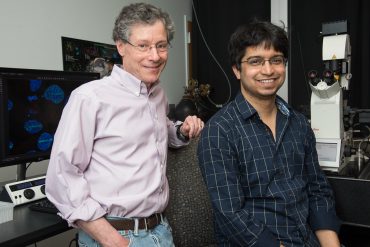
Dec. 22, 2020
Finding how a Virus Navigates the Nucleus of a Cell
Kinjal Majumder and David Pintel | photo by Roger Meissen, Bond LSC By Becca Wolf | Bond LSC Four years of hard work certainly paid off for Kinjal Majumder. Majumder, a former postdoctoral fellow in the Pintel lab at Bond Life Sciences Center, spent the past four years looking at how the parvovirus, Minute Virus of Mice (MVM), is getting to the sites in the nucleus that it needs to replicate. Parvovirus is used as a model to study virus behavior because it is a simple, single stranded DNA virus. MVM infects mouse cells and transformed…
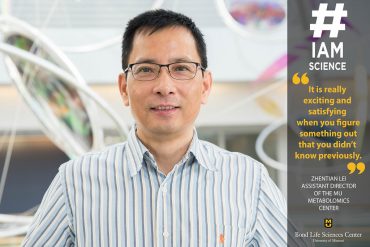
Dec. 11, 2020
#IAmScience Zhentian Lei
By Becca Wolf | Bond LSC Columbia has been very different than Ardmore, Oklahoma, for Zhentian Lei. But the move from the Samuel Roberts Noble Foundation, a nonprofit agricultural research center, to Bond Life Sciences Center has been a good one for the researcher. “I like it here much better,” Lei said. “The town that we used to live in Oklahoma is very small and at least 100 miles from other universities. So, it wasn’t convenient to collaborate or visit other labs. It’s not like here where you can just walk across the campus to another building and…
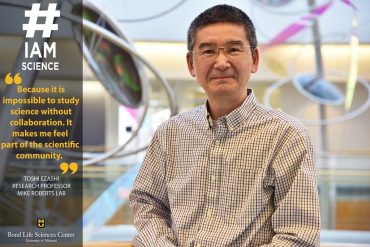
Dec. 4, 2020
#IAmScience Toshi Ezashi
By Lauren Hines | Bond LSC Despite his quiet demeanor, Toshi Ezashi leaves an impression on those who meet him in the halls of Bond LSC through his quiet intensity and constant courtesy. The research professor was here before the “Joy of Discovery” sculpture in the atrium was built or the living plant wall was hung, calmly making progress with stem cells as part of the Mike Roberts lab team. “I’m mainly doing research on trophoblast that compose the main component of the placenta tissue,” said Ezashi, who first came to Mizzou in 1995. “Using stem…
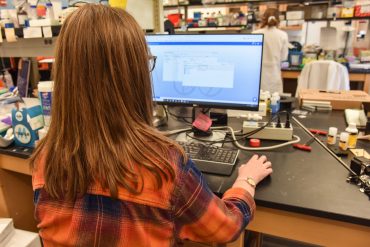
Dec. 3, 2020
Connecting the World Through the Cloud
Maria Lusardi-Claire, an undergraduate student in the Mendoza lab, uses the cloud, a program apart of CyVerse. | photo by Becca Wolf, Bond LSC By Becca Wolf | Bond LSC Clouds come in many shapes and sizes. Some are big and fluffy, others dark and ominous. Or, as in David Mendoza’s case, the cloud is a hub of experiment information. Mendoza, an associate professor of plant sciences and scientist in Bond Life Sciences Center, recently joined the CyVerse, a cyberinfrastructure system used by Mendoza’s lab that acts as and allows his team and collaborators to see data in…
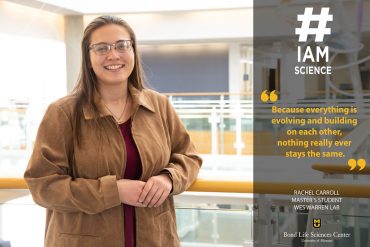
Nov. 20, 2020
#IAmScience Rachel Carroll
By Becca Wolf | Bond LSC Growing up with many pets and watching Animal Planet, Rachel Carroll, a master’s student in the Wes Warren lab at Bond Life Sciences Center, has known one thing about what she wanted to do for a living. “I just decided that I wanted to find a career where I could work with animals,” Carroll said. “As I got older, I realized that there are a lot of things affecting our planet that are causing some of these animals and ecosystems to disappear. These ecosystems are important, and their disappearance really refined my…
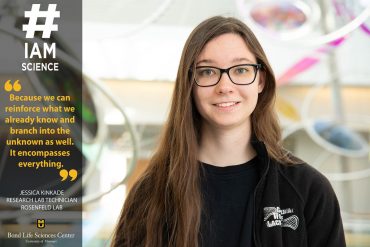
Nov. 6, 2020
#IAmScience Jessica Kinkade
By Becca Wolf | Bond LSC Growing up in Columbia, Jessica Kinkade never thought she would end up working in town. “I never expected to come back here, but it’s neat that it worked out that way,” Kinkade said. “It’s nice to be able to see my family and work in a familiar place that I’ve lived my whole life.” Kinkade went to college about 30 minutes east of MU at Westminster College in Fulton, MO. “I always had an interest in science, especially natural and biological sciences, ever since I was little,” Kinkade said. “I was always…
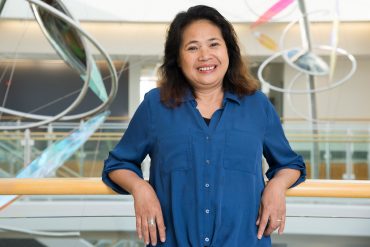
Nov. 2, 2020
Seed size matters: searching for a gene to make a bigger soybean
Bing Stacey | photo by Mariah Cox, Bond LSC By Becca Wolf | Bond LSC Patience is a virtue, at least it is for Bing Stacey. Stacey recently completed a project that took her a total of eight years. It took her five years to develop a fast neutron mutant population and it took an additional three years to screen the population to identify a mutant that showed increase soybean seed size and then identifying the causative gene. This gene, GmKIX8-1, and the seed size QTL, qSW17-1, can potentially be exploited for increasing yield in soybeans. Being able…
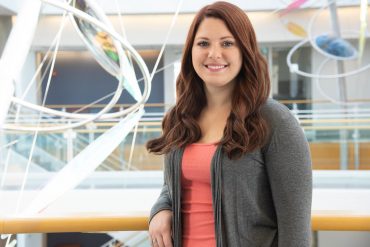
Oct. 28, 2020
Using improved technology to create an Immune Cell Atlas
Ashley Meyer | photo by Mariah Cox, Bond LSC By Becca Wolf | Bond LSC When given an opportunity to use the newest technology, one has to take it. Ashley Meyer, the lab supervisor of the Wes Warren lab at Bond Life Sciences Center, recently started using the improved technology of single cell RNA sequencing to create an Immune Cell Atlas for chickens. This search browser of sorts allows people to search for cells and gene expression in chickens. “It would be a platform for researchers to have a baseline of what should be normal, and then be…
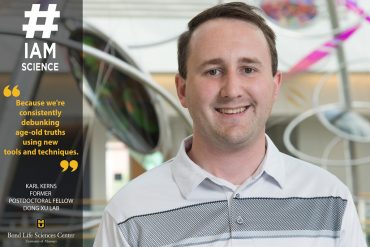
Oct. 23, 2020
#IAmScience Karl Kerns
By Becca Wolf | Bond LSC It’s all about the journey and Karl Kerns has been places. Originally from a small town in southwestern Iowa, Kerns did his undergrad years at Iowa State University (ISU), taking internships in Maryland, Texas, southeast Asia, and southern Australia, among other places that focused on animal physiology and fertilization. “I do like traveling just in the sense of vacation. I like having a purpose while traveling. It’s hard for me to sit back and relax and be in vacation mode,” Kerns said. This focus and determination eventually brought him to Mizzou where…

Oct. 14, 2020
Regulators Classify Gene-Edited Rice Varieties with Disease Resistance as Equivalent to Conventional Varieties
Crops resist bacterial leaf blight; ruling clears path to provide smallholder farmers with a safe, affordable option for preventing destructive disease Rice farms in Vietnam. Columbia and St. Louis, MO, October 14, 2020 – The Healthy Crops team, with support from the Bill & Melinda Gates Foundation, have used gene editing tools to develop new varieties of disease-resistant rice that regulators in the United States and Colombia have determined are equivalent to what could be accomplished with conventional breeding. Bacterial blight can reduce rice yields by up to 70 percent, with the heaviest losses typically experienced by smallholder rice…
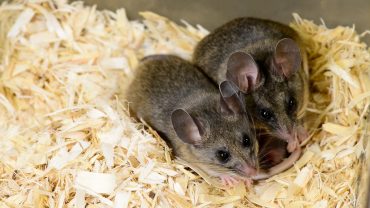
Oct. 12, 2020
Finding a Link between Xenoestrogens and Autism
California mice | photo by Roger Meissen, Bond LSC By Becca Wolf | Bond LSC It’s hard to see a family member treated differently because of a behavior disorder, but those with relatives diagnosed with Autism Spectrum Disorder (ASD) know its impact. Since it affects how people act, communicate, and learn, people with ASD often get bullied or feel left out because of these behaviors. Sarabjit Kaur, a former undergraduate researcher in the Cheryl Rosenfeld lab at the Bond Life Sciences Center, witnessed this stigma firsthand growing up with a brother who is autistic. Going to college, she…
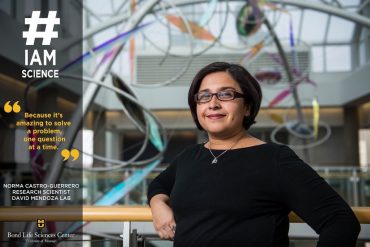
Oct. 9, 2020
#IAmScience Norma Castro-Guerrero
By Becca Wolf | Bond LSC If you like your work, you won’t ever work a day in your life. That’s the case for Norma Castro-Guerrero, a research scientist in David Mendoza’s lab at Bond Life Sciences Center. Having a good attitude and making the most of everything is something she strives to do. “I wake up every day and I am already thinking about what I need to do,” Castro-Guerrero said. “Time flies by during the day. I think that’s a…